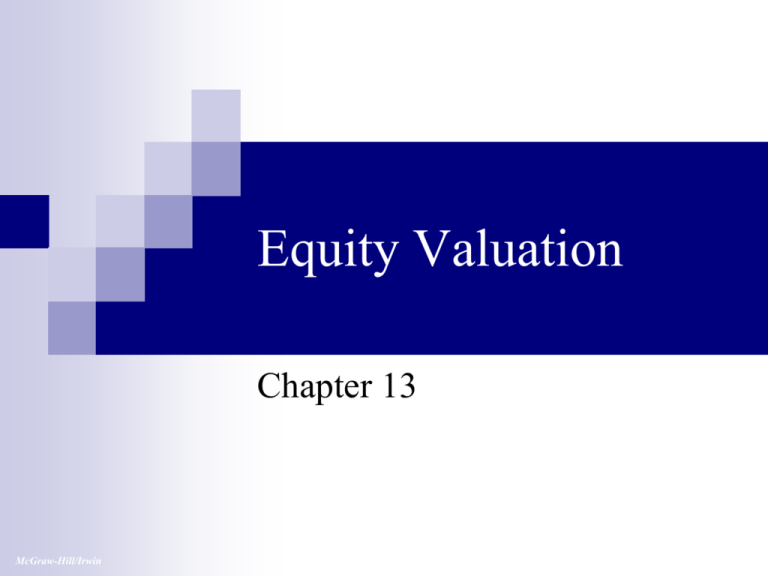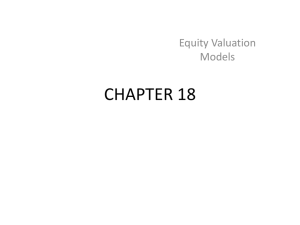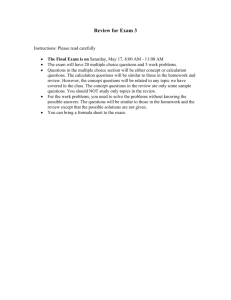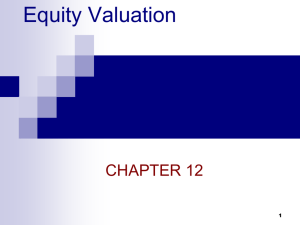
Equity Valuation
Chapter 13
McGraw-Hill/Irwin
Copyright © 2013 by The McGraw-Hill Companies, Inc. All rights reserved.
Book Value
Historical
Values recorded on the firm’s
financial statements
BV
Equity = Total Assets – Total Liabilities
The values are historical and may not reflect
current market conditions/values
Limits
the informativeness of these values
2
13-2
Valuing Stock: Intrinsic v Price
An investors purchasing a share is acquiring
the cash flows associated with that share
The present value of these cash flows is the
Intrinsic Value
For
now assume intrinsic value is the same as
market value, we will relax this assumption later in
the semester
3
13-3
Expected HPR
When the market price = intrinsic value the
E(r) = Div Yield + Capital Gain
Div
Yield = D1 / P0
Capital Gain = (P1 - P0) / P0
E(r) = D1 / P0 + (P1 - P0) / P0
Also
known as the market capitalization rate
4
13-4
Valuing Common Stock
The price should reflect the PV of future cash
flows
So
will an investor planning on selling his
share in a year be willing to pay today?
The
investor buying the share next year plans
on selling it a year later so he is only willing to
pay?
5
13-5
Keep Going
This process can be repeated into the future
Div1
Div 2
Div H PH
P0
...
1
2
H
(1 k ) (1 k )
(1 k )
Using summation:
P0 = H Dh / (1 + k)h + PH / (1 + k)H
What happens to PH as H approaches infinity?
ASIDE: Will an investor’s expected holding
period affect the price they are willing to pay
today?
6
13-6
Constant Dividend
How do you value a stock that will pay a
constant dividend?
Hint:
what does the cash flow stream look similar
to?
7
13-7
Constant Dividend Example
What is the value of a stock that is expected to
pay a constant dividend of $2 per share?
The
required rate of return is 10%
8
13-8
Constant Dividend Example
What is the market capitalization rate of a
stock that is selling for $60, that is expected to
pay a constant dividend of $2 per share?
9
13-9
When Dividends Grow
Now lets assume that the firm and its dividend
will grow at g forever
Dividends now:
Div 1 Div 0 (1 g )
D iv 2 D iv 1 (1 g ) D iv 0 (1 g )
2
D iv 3 D iv 2 (1 g ) D iv 0 (1 g ) 3
10
13-10
DDM with Constant Growth
V0 = D1 / (k-g)
V0 = {D0*(1+g) }/ (k-g)
Is a stock more or less valuable when
dividends grow?
11
13-11
Growing Dividend Example
Geneva steel just paid a dividend of $2.10.
Dividend payments are expected to grow at a
constant rate of 6%. The appropriate discount
rate is 12%. What is the price of Geneva
stock?
12
13-12
Firm Life Cycles
Firms generally grow faster when they are
young, then growth slows as the firm matures
Two-Stage DDM (Multistage Growth Models)
Allow
dividends to grow at different rates as firm
matures
13
13-13
Differential Growth Rates
Dividends will grow at g1 for T years and g2 thereafter
Step 1: An T-year annuity growing at rate g1
PA
C1
(1 g1 )
1
k g1
(1 k )
{
}
T
Step 2: A growing perpetuity at rate g2
PN = DivN+1 / (k-g2)
Step 3: PB = PN / (1+k)T
Step 4: P0 = PA + PB
14
Non-Constant Growth Example
(Given)
Websurfers Inc, a new internet firm is expected to do
very well during its initial growth period. Investors
expect its dividends to grow at 25% for the next 3
years. Obviously one cannot expect such
extraordinary growth to continue forever, and it is
expected that dividends will grow at 5% after year 3
in perpetuity. Its current dividend is $1/share.
Required rate of return on the stock = 10%. Calculate
what the current price should be.
15
13-15
Websurfer Inc, Example (Given) 1*1.25
1*1.25
= 1.25
0
1
1*1.252
=1.56
2
1*1.253
= 1.95
1*1.253*1.05
= 2.05
3
4
1.PA=[(1.25)/(0.10-0.25)]*[1-{1.25/1.10}3] =
3
*1.052
= 2.15
5
3.90
2.PN
={2.05}/(0.10-0.05) = 41.00
3.PB =41.00/(1.103) = 30.80
4.P0 = PA + PB = 3.90+ 30.80 = $34.70
16
13-16
A Differential Growth Example
A common stock just paid a dividend of $2. The
dividend is expected to grow at 8% for 3 years,
then it will grow at 4% in perpetuity. R=12%
What is the stock’s intrinsic value?
PA =
2. PN =
3. PB =
4. P0 = PA + PB =
1.
17
13-17
Problem 1 (Given)
A firm is expected to grow at 25% for the next 3
years. Its growth is expected to decline to
15% for the following 4 years. It is then
expected to grow at 5% in perpetuity. Find
the current share price if the current dividend
is $1 and the discount rate is 10%.
18
13-18
Problem 1 (Given)
A firm is expected to grow at 25% for the next 3 years. Its growth is expected to
decline to 15% for the following 4 years. It is then expected to grow at 5% in
perpetuity. Find the current share price if the current dividend is $1 and the
discount rate is 10%.
PA=[(1.25)/(0.10-0.25)]*[1-{1.25/1.10}3]=3.89
PN1 ={1*1.253*1.15}/(0.10-0.15)]*
[1-{1.15/1.10}4]=8.76
PB =8.76/(1.103) = 6.58
PN2 ={1*1.253*1.154*1.05}/(0.10-0.05)] = 71.80
PC =71.80/(1.107) = 36.83
P0 = PA + PB + Pc = 3.89+6.58+36.83 = $47.30
19
13-19
Problem 2 (Given)
Consider a firm whose dividend growth is
expected to decline gradually. For the next two
years, the growth is expected to be 20%. In the
following years, it is expected to grow at 18%,
13% and 10%. From year 6 onwards,
dividends are expected to grow at 5% for
perpetuity. Assume the current dividend is $1
and the required rate of return is 10%. What is
the current price?
20
13-20
Problem 2: Phase 1 – Years 1-5
(Given)
DIV1 = 1.00 * 1.20 = 1.20
DIV2 = 1.20 * 1.20 = 1.44
DIV3 = 1.44 * 1.18 = 1.70
DIV4 = 1.70 * 1.13 = 1.92
DIV5 = 1.92 * 1.10 = 2.11
PA = 1.2/1.1 + 1.44/1.12 + 1.70/1.13 +
1.92/1.14 + 2.11/1.15 = 6.18
21
13-21
Problem 2 Phase 2 – Years 6-
(Given)
DIV6 = 2.11 * 1.05 = 2.22
PN = DIV6 / (r-g) = 2.22/(0.10-0.05) = 44.4
PB = 44.4 * 1/1.15 = 27.57
Current Price = 6.18 + 27.57 = $33.75
22
13-22
What to do with Cash
Once a firm has paid everyone, it has two
chooses with what to do with any remaining
money
Give
it to shareholders
Who can invest it themselves
Reinvest
it in the company
Growth the firm
When should the firm give the cash to
investors? Reinvest?
23
13-23
How Fast Can a Firm Grow?
The firm’s growth is determined by how much
it re-invests (plowback ratio) & the return on
its re-investment
Plowback
(b)how much of every dollar is re-invest
Earnings Retention Ratio
REMEMBER: Plowback + Payout = 1
Return
on investment is the firm’s ROE
g = plowback ratio * ROE
24
13-24
Calculating Growth Rates (g)
Consider two firms with earnings of $5 &
k=12.5%
Cash Cow pays out all earnings as dividends
CC’s
growth rate is _______
CC’s share price is _______
Growth Prospects wants to grow → Div Payout = 40%
& ROE is 15%
GP’s growth rate is _______
GP’s share price is _______
25
13-25
Alternative Growth Valuation
Price is composed of:
The
value of the current operations (100% Div Payout)
EPS1 / k
Growth
opportunities
PVGO
P0 = EPS1 / k + PVGO
26
13-26
Who cares about PVGO?
For what type of stock is the PVGO more
important?
Growth
or Value stocks
27
13-27
PVGO Example
A
firm reinvests 60% of its earnings in
projects with ROE of 10%,
capitalization rate is 15%. Expected
year-end dividend is $2/share, paid out
of earnings of $5/share.
Compute
the firm’s share price?
What is the per share value of the firm’s
current assets?
What is the per share PVGO?
28
Price-Earnings Ratio
The price-earnings ratio is calculated as the
current stock price divided by annual EPS.
Wall Street Journal uses last 4 quarter’s
earnings
The
Price per share
P/E ratio
EPS
Many analysts use this to determine how the
market feels about a company
29
13-29
Price-Earnings Ratio Breakdown
P0 = EPS1 / k + PVGO
↓
P0 1 PVGO
1
E
E1 k
k
P/E can be thought of as a ratio of growth
options to current assets
30
Price-Earnings Ratio and Growth
When PVGO=0, P0=E1 / k. The stock is valued
like a constant perpetuity.
P/E rises dramatically with PVGO.
High P/E indicates that the firm has ample
growth opportunities.
31
Price Earnings Ratio 2nd Breakdown
P0 = Div1 / (k –g)
Div1:
is E1 * (1+b)
g is ROE * b
P0 = {E1 * (1+b) }/ {k –(ROE * b)}
P0
1 b
1 b
E1 k ( ROE * b) k g
32
13-32
Price-Earnings Ratio Implications
P0
1 b
1 b
E1 k ( ROE * b) k g
Since riskier stocks have higher k (rates of
returns) this implies they will also have lower
P-E multiples
P/E increases:
As
ROE increases
As plowback increases IF ROE>k
33
ROE & Plowback on Growth and the P/E Ratio, k=12%
34
13-34
Issues With P/E Analysis
Uses
accounting earnings
Earnings Management
Choices on GAAP
Inflation
Reported earnings fluctuate around the
business cycle
35
Figure 13.4 Earnings Growth for Two Companies
Earnings per share (1995 = 1.0)
6.0
5.0
Con Ed
Intel
4.0
3.0
2.0
1.0
0.0
1995
1997
1999
2001
2003
2005
2007
2009
2011
36
13-36
Figure 13.5 Price-Earnings Ratios
60
Con Ed
Intel
50
P/E ratio
40
30
20
10
0
1995
1997
1999
2001
2003
2005
2007
2009
2011
37
13-37
Industrial P/E Ratios
Aerospace/defense
Integrated oil & gas
Money center banks
Health care plans
Computer systems
Telecom services
Industrial metals
Electric utilities
Home improvement
Pharmaceuticals
Chemical products
Application software
Asset management
Food products
Restaurants
Auto manufacturers
Trucking
Heavy construction
Business software
Biotech
8.5
10.2
11.0
11.8
13.2
14.7
14.9
15.6
16.5
17.2
17.4
17.5
17.5
21.1
21.4
25.3
28.0
32.4
34.7
57.8
0
10
20
30
40
50
60
P/E ratio
38
13-38
Other Comparative Valuation Ratios
Price-to-book: Indicates how aggressively the
market values the firm
Price-to-cash-flow: Cash flow less affected by
accounting decisions than earnings
Price-to-sales: For start-ups with no earnings
39
13-39
Free Cash Flow to the Firm
Value the firm by discounting its free cash
flows by WACC
Free cash flow to the firm, FCFF, equals:
After
tax EBIT
Plus depreciation
Minus capital expenditures
Minus increase in net working capital
FCFF= EBIT(1-tc) + Dep - Cap Ex - Inc. NWC
40
Using FCFF to Value the Firm
FCFF= EBIT(1-tc) + Dep - Cap Ex Inc. NWC
FCFFt 1
Pt
WACC g
41
13-41
Free Cash Flow to Equityholders
Two ways to determine the value of Equity
Firm Value minus Debt
2. Discounting free cash flows to equity by cost of
equity
1.
Free cash flow to equity, FCFE, equals:
FCFF
Minus
Interest Expense After Tax
Plus Increase in Net Debt
FCFE= FCFF – Int Exp * (1-tc) + Inc. net Debt
42
Finding the Value of Equity
Equity = Firm Value – Debt
Or
FCFE= FCFF – Int Exp * (1-tc) + Inc. net Debt
FCFEt 1
Equity t
kE g
43
13-43
Stock Value Represents:
Present value of expected future dividends,
Present value of free cash flow,
Present value of average future earnings under
a no-growth policy plus the present value of
growth opportunities
44
13-44
Free Cash Flow to the Firm
Eagle Products’ EBIT is $400, its tax rate is
30%, depreciation is $16, capital expenditures
are $56, and the planned increase in net
working capital is $25.
What is the free cash flow to the firm?
45
13-45
MoMi Corp’s operating cash flows before interest
and taxes was $2M last year
MoMi
expects this to grow by 5% per year forever
To make this happen, MoMi will have to invest 20%
of pretax cash flow each year.
Depreciation last year was $200K and is expected to
grow at the same rate as OCF
Market capitalization rate for unleveraged CF is 12%
WACC
Firm
has $4M in debt outstanding
The tax rate is 35%
What is the value of MoMi?
What is the value of MoMi’s equity?
46
13-46
FCFE Example
Acme reports free cash flow to the firm of $205
million. The interest expense to the firm is $22
million. If the tax rate is 35% and the net debt of
the firm increased by $25 million, what is the
approximate market value of equity if the FCFE
grows at 2% and the cost of equity is 11%?
47
13-47
Different Models Different Values
In
practice
Values from these models differ
Analysts are always forced to make
simplifying assumptions
Problems with DCF
Calculations
are sensitive to small changes
in inputs
Growth opportunities and growth rates are
hard to pin down
48
13-48









